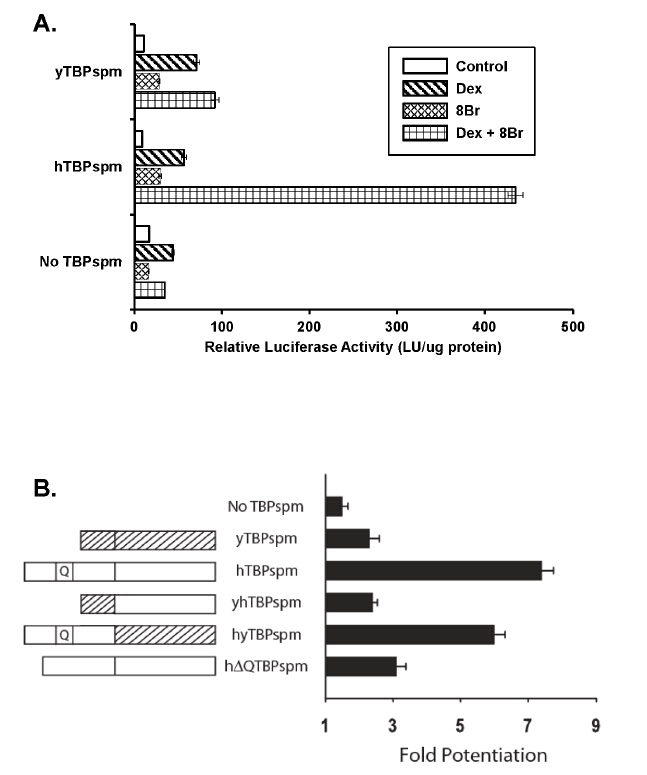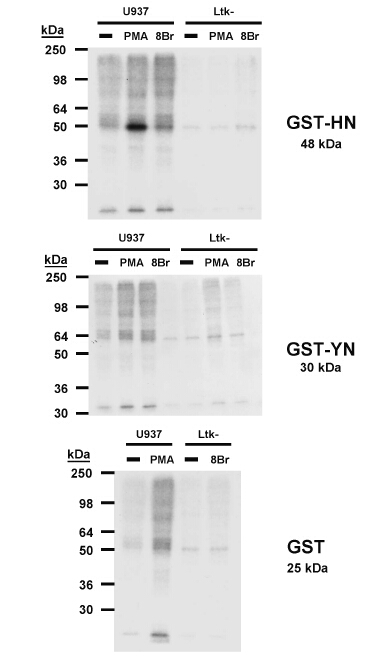|
[1]
|
Goodrich JA,Tjian R (1994) TBP-TAF complexes: selectivity factors for eukaryotic transcription. Curr Opin Cell Biol 6: 403-409. doi: 10.1016/0955-0674(94)90033-7

|
|
[2]
|
Buratowski S (1994) The basics of basal transcription by RNA polymerase II. Cell 77: 1-3. doi: 10.1016/0092-8674(94)90226-7

|
|
[3]
|
Evans RM (1998) The steroid and thyroid hormone receptor superfamily. Science 240: 889-895.
|
|
[4]
|
Dasgupta AB,Lonard DM,O'Malley BW (2014) Nuclear receptor coactivators: master regulators of human health and disease. Annu Rev Med 65: 279-292. doi: 10.1146/annurev-med-051812-145316

|
|
[5]
|
Xu J,Li Q (2003) Review of the in vivo Functions of the p160 Steroid Receptor Coactivator Family. Mol Endocrinol 17:1681-1692. doi: 10.1210/me.2003-0116

|
|
[6]
|
Smith CL,DeVera DG,Lamb DJ,et al. (2002) Genetic ablation of the steroid receptor coactivator-ubiquitin ligase,E6-AP,results in tissue-selective steroid hormone resistance and defects in reproduction. Mol Cell Biol 22: 525-535. doi: 10.1128/MCB.22.2.525-535.2002

|
|
[7]
|
Beitel LK,Elhaji YA,Lumbroso R,et al. (2002) Cloning and characterization of an androgen receptor N-terminal-interacting protein with ubiquitin-protein ligase activity. J Mol Endocrinol 29: 41-60. doi: 10.1677/jme.0.0290041

|
|
[8]
|
Khan SH,Ling J,Kumar R (2011) TBP binding-induced folding of the glucocorticoid receptor AF1 domain facilitates its interaction with steroid receptor coactivator-1. PLoS One 6: e21939
|
|
[9]
|
Kumar R,Moure CM,Khan SH,et al. (2013) Regulation of the structurally dynamic N-terminal domain of progesterone receptor by protein-induced folding. J Biol 288: 30285-3099.
|
|
[10]
|
Warnmark A,Wikstrom A,Wright AP,et al. (2001) The N-terminal regions of estrogen receptor alpha and beta are unstructured in vitro and show different TBP binding properties. J Biol Chem 276: 45939-45944. doi: 10.1074/jbc.M107875200

|
|
[11]
|
Keaveney M,Berkenstam A,Feigenbutz M,et al. (1993) Residues in the TATA-binding protein required to mediate a transcriptional response to retinoic acid in EC cells. Nature 365: 562-566. doi: 10.1038/365562a0

|
|
[12]
|
Pugh BF,Tjian R (1990) Mechanism of transcriptional activation by Sp1: evidence for coactivators. Cell 61: 1187-1197. doi: 10.1016/0092-8674(90)90683-6

|
|
[13]
|
Strubin M,Struhl K (1992) Yeast and human TFIID with altered DNA-binding specificity for TATA elements. Cell 68:721-730. doi: 10.1016/0092-8674(92)90147-5

|
|
[14]
|
Nordeen SK,Moyer ML,Bona BJ (1995) Modulation of glucocorticoid-regulated transcription by purines: novel characteristics and implications for tissue specificity of steroid responses. Endocrinology 136: 1120-1127.
|
|
[15]
|
Beck CA,Weigel NL,Moyer ML,et al. (1993) The progesterone antagonist RU486 acquires agonist activity upon stimulation of cAMP signaling pathways. Proc Natl Acad Sci U S A 90: 4441-4445. doi: 10.1073/pnas.90.10.4441

|
|
[16]
|
Nordeen SK,Bona BJ,Moyer ML (1993) Latent agonist activity of the steroid antagonist,RU486,is unmasked in cells treated with activators of protein kinase A. Mol Endocrinol 7: 731-742.
|
|
[17]
|
Moyer ML,Borror KC,Bona BJ,et al. (1993) Modulation of cell signaling pathways can enhance or impair glucocorticoid-induced gene expression without altering the state of receptor phosphorylation. J Biol Chem 268: 22933-22940.
|
|
[18]
|
Nordeen SK,Moyer ML,Bona BJ (1994) The coupling of multiple signal transduction pathways with steroid response mechanisms. Endocrinology 134: 1723-1732.
|
|
[19]
|
Nordeen SK (1994) Potentiation of glucocorticoid-mediated induction of the mouse mammary tumor virus promoter in mammary carcinoma cells by activation of protein kinase C. Biochem Biophys Res Commun 198: 1183-1188. doi: 10.1006/bbrc.1994.1167

|
|
[20]
|
Dutertre M,Smith CL (2003) Ligand-independent interactions of p160/steroid receptor coactivators and CREB-binding protein (CBP) with estrogen receptor-alpha: regulation by phosphorylation sites in the A/B region depends on other receptor domains. Mol Endocrinol 17: 1296-1314. doi: 10.1210/me.2001-0316

|
|
[21]
|
Wu RC,Smith CL,O'Malley BW (2005) Transcriptional regulation by steroid receptor coactivator phosphorylation. Endocr Rev 26: 393-399. doi: 10.1210/er.2004-0018

|
|
[22]
|
Kato S,Masuhiro Y,Watanabe M (2000) Molecular mechanism of a cross-talk between oestrogen and growth factor signaling pathways. Genes Cells 5: 593-601. doi: 10.1046/j.1365-2443.2000.00354.x

|
|
[23]
|
Kit S,Dubbs DR,Piekarksi LJ,et al. (1963) Deletion of thymidine kinase activity from L cells resistant to bromodeoxyuridine. Exp Cell Res 31: 297-312. doi: 10.1016/0014-4827(63)90007-7

|
|
[24]
|
Ralph P,Moore MA,Milsson K (1976) Lysozyme synthesis by established human and murine histiocytic lymphoma cell lines. J Exp Med 143: 1528-1533. doi: 10.1084/jem.143.6.1528

|
|
[25]
|
Gatlin J,Campbell LH,Schmidt MG,et al. (1995) Direct-rapid (DR) mutagenesis of large plasmids using PCR. Biotechniques 19: 559-564.
|
|
[26]
|
Nordeen SK (1988) Luciferase reporter gene vectors for analysis of promoters and enhancers. Biotechniques 6: 454-458.
|
|
[27]
|
Lieberman BA,Bona BJ,Edwards DP,et al. (1993) The constitution of a progesterone response element. Mol Endocrinol 7: 515-527.
|
|
[28]
|
Biggs JR,Ahn NG,Kraft AS (1998) Activation of the mitogen-activated protein kinase pathway in U937 leukemic cells induces phosphorylation of the amino terminus of the TATA-binding protein. Cell Growth Differ 9: 667-676.
|
|
[29]
|
Fujimoto N,Katzenellenbogen BS (1994) Alteration in the agonist/antagonist balance of antiestrogens by activation of protein kinase A signaling pathways in breast cancer cells: antiestrogen selectivity and promoter dependence. Mol Endocrinol 8: 296-304.
|
|
[30]
|
Keenan CR,Mok JS,Harris T,et al (2014) Bronchial epithelial cells are rendered insensitive to glucocorticoid transactivation by transforming growth factor-β1. Respiratory Res 15: 55
|
|
[31]
|
Piovan E,Yu J,Tosello V,et al. (2013) Direct reversal of glucocorticoid resistance by AKT inhibition in acute lymphoblastic leukemia. Cancer Cell 24: 766-776. doi: 10.1016/j.ccr.2013.10.022

|
|
[32]
|
Beck IM,Vanden Berghe W,Vermeulen L (2009) Crosstalk in inflammation: the interplay of glucocorticoid receptor-based mechanisms and kinases and phosphatases. Endocr Rev 30: 830-882. doi: 10.1210/er.2009-0013

|
|
[33]
|
Kumar R,Calhoun WJ (2008) Differential regulation of the transcriptional activity of the glucocorticoid receptor through site-specific phosphorylation. Biologics 2: 845-854.
|
|
[34]
|
Ward RD,Weigel NL (2009) Steroid receptor phosphorylation: Assigning function to site-specific phosphorylation. Biofactors 35: 528-536. doi: 10.1002/biof.66

|
|
[35]
|
Chen W,Dang T,Blind RD,et al. (2008) Glucocorticoid receptor phosphorylation differentially affects target gene expression. Mol Endocrinol 22: 1754-66. doi: 10.1210/me.2007-0219

|
|
[36]
|
Espinas ML,Roux J,Pictet R,et al. (1995) Glucocorticoids and protein kinase A coordinately modulate transcription factor recruitment at a glucocorticoid-responsive unit. Mol Cell Biol 15: 5346-5354.
|
|
[37]
|
Rowan BG,Garrison N,Weigel NL,et al. (2000) 8-Bromo-cyclic AMP induces phosphorylation of two sites in SRC-1 that facilitate ligand-independent activation of the chicken progesterone receptor and are critical for functional cooperation between SRC-1 and CREB binding protein. Mol Cell Biol 20: 8720-8730. doi: 10.1128/MCB.20.23.8720-8730.2000

|
|
[38]
|
Johnson AB,O'Malley BW (2012) Steroid receptor coactivators 1,2,and 3: critical regulators of nuclear receptor activity and steroid receptor modulator (SRM)-based cancer therapy. Mol Cell Endocrinol 348: 430-439. doi: 10.1016/j.mce.2011.04.021

|
|
[39]
|
Das D,Scovell WM (2001) The binding interaction of HMG-1 with the TATA-binding protein/TATA complex. J Biol Chem 276: 32597-32605. doi: 10.1074/jbc.M011792200

|
|
[40]
|
Boonyaratanakornkit V,Melvin V,Prendergast P,et al. (1998) High-mobility group chromatin proteins 1 and 2 functionally interact with steroid hormone receptors to enhance their DNA binding in vitro and transcriptional activity in mammalian cells. Mol Cell Biol 18: 4471-4487.
|
|
[41]
|
Melvin VS,Edwards DP (1999) Coregulatory proteins in steroid hormone receptor action: the role of chromatin high mobility group proteins HMG-1 and -2. Steroids 64: 576-586. doi: 10.1016/S0039-128X(99)00036-7

|
|
[42]
|
Hernandez N (1993) TBP,a universal eukaryotic transcription factor? Genes Dev 7:1291-1308. doi: 10.1101/gad.7.7b.1291

|
|
[43]
|
Mittal V,Hernandez N (1997) Role for the amino-terminal region of human TBP in U6 snRNA transcription. Science 275: 1136-1140. doi: 10.1126/science.275.5303.1136

|
|
[44]
|
Mittal V,Ma B,Hernandez N (1999) SNAP(c): a core promoter factor with a built-in DNA-binding damper that is deactivated by the Oct-1 POU domain. Genes Dev 13: 1807-1821. doi: 10.1101/gad.13.14.1807

|
|
[45]
|
Zhao X,Herr W (2002) A regulated two-step mechanism of TBP binding to DNA: a solvent-exposed surface of TBP inhibits TATA box recognition. Cell 108: 615-627. doi: 10.1016/S0092-8674(02)00648-7

|
|
[46]
|
Um M,Yamauchi J,Kato S,et al. (2001) Heterozygous disruption of the TATA-binding protein gene in DT40 cells causes reduced cdc25B phosphatase expression and delayed mitosis. Mol Cell Biol 21: 2435-2448. doi: 10.1128/MCB.21.7.2435-2448.2001

|
|
[47]
|
Schmidt EE,Bondareva AA,Radke JR,et al. (2003) Fundamental cellular processes do not require vertebrate-specific sequences within the TATA-binding protein. J Biol Chem 278: 6168-6174. doi: 10.1074/jbc.M211205200

|
|
[48]
|
Hobbs NK,Bondareva AA,Barnett S,et al. (2002) Removing the vertebrate-specific TBP N terminus disrupts placental beta2m-dependent interactions with the maternal immune system. Cell 110: 43-54. doi: 10.1016/S0092-8674(02)00806-1

|















 DownLoad:
DownLoad: